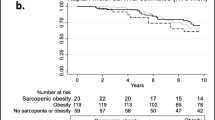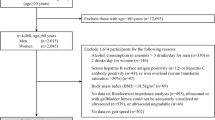Abstract
Objectives
To determine: 1) whether sarcopenic-obesity is a stronger predictor of cardiovascular disease (CVD) than either sarcopenia or obesity alone in the elderly, and 2) whether muscle mass or muscular strength is a stronger marker of CVD risk.
Design
Prospective cohort study.
Participants
Participants included 3366 community-dwelling older (65 years) men and women who were free of CVD at baseline.
Measurements
Waist circumference (WC), bioimpedance analysis, and grip strength were used to measure abdominal obesity, whole-body muscle mass, and muscular strength, respectively. Subjects were classified as normal, sarcopenic, obese, or sarcopenic-obese based on measures of WC and either muscle mass or strength. Participants were followed for 8 years for CVD development and proportional hazard regression models were used to compare risk estimates for CVD in the four groups after adjusting for age, sex, race, income, smoking, alcohol, and cognitive status.
Results
Compared with the normal group, CVD risk was not significantly elevated within the obese, sarcopenic, or sarcopenic-obese groups as determined by WC and muscle mass. When determined by WC and muscle strength, CVD risk was not significantly increased in the sarcopenic or obese groups, but was increased by 23% (95% confidence interval: 0.99–1.54, P=0.06) within the sarcopenic-obese group.
Conclusion
Sarcopenia and obesity alone were not sufficient to increase CVD risk. Sarcopenic-obesity, based on muscle strength but not muscle mass, was modestly associated with increased CVD risk. These findings imply that strength may be more important than muscle mass for CVD protection in old age.
Similar content being viewed by others
References
Baumgartner RN. Body composition in healthy aging. Ann N Y Acad Sci 2000;904:437–448.
Baumgartner RN, Wayne SJ, Waters DL, Janssen I, Gallagher D, Morley JE. Sarcopenic obesity predicts instrumental activities of daily living disability in the elderly. Obes Res 2004;12:1995–2004.
Davison KK, Ford ES, Cogswell ME, Dietz WH. Percentage of body fat and body mass index are associated with mobility limitations in people aged 70 and older from NHANES III. J Am Geriatr Soc 2002;50:1802–1809.
Zoico E, Di Francesco V, Guralnik JM et al. Physical disability and muscular strength in relation to obesity and different body composition indexes in a sample of healthy elderly women. Int J Obes Relat Metab Disord 2004;28:234–241.
Despres JP, Lemieux S, Lamarche B et al. The insulin resistance-dyslipidemic syndrome: contribution of visceral obesity and therapeutic implications. Int J Obes Relat Metab Disord 1995;19Suppl 1:S76–86.
Boyko EJ, Fujimoto WY, Leonetti DL, Newell-Morris L. Visceral adiposity and risk of type 2 diabetes: a prospective study among Japanese Americans. Diabetes Care 2000;23:465–471.
Despres JP, Moorjani S, Lupien PJ, Tremblay A, Nadeau A, Bouchard C. Regional distribution of body fat, plasma lipoproteins, and cardiovascular disease. Arteriosclerosis 1990;10:497–511.
Nicklas BJ, Penninx BW, Cesari M et al. Association of visceral adipose tissue with incident myocardial infarction in older men and women: the Health, Aging and Body Composition Study. Am J Epidemiol 2004;160:741–749.
Snijder MB, Henry RM, Visser M et al. Regional body composition as a determinant of arterial stiffness in the elderly: The Hoorn Study. J Hypertens 2004;22:2339–2347.
Snijder MB, Dekker JM, Visser M et al. Larger thigh and hip circumferences are associated with better glucose tolerance: the Hoorn study. Obes Res 2003;11:104–111.
Jurca R, Lamonte MJ, Barlow CE, Kampert JB, Church TS, Blair SN. Association of muscular strength with incidence of metabolic syndrome in men. Med Sci Sports Exerc 2005;37:1849–1855.
Schrager MA, Metter EJ, Simonsick E et al. Sarcopenic obesity and inflammation in the InCHIANTI study. J Appl Physiol 2007;102:919–925.
Pearson TA, Mensah GA, Alexander RW et al. Markers of inflammation and cardiovascular disease: application to clinical and public health practice: A statement for healthcare professionals from the Centers for Disease Control and Prevention and the American Heart Association. Circulation 2003;107:499–511.
Aubertin-Leheudre M, Lord C, Goulet ED, Khalil A, Dionne IJ. Effect of sarcopenia on cardiovascular disease risk factors in obese postmenopausal women. Obesity (Silver Spring) 2006;14:2277–2283.
Fried LP, Borhani NO, Enright P et al. The Cardiovascular Health Study: design and rationale. Ann Epidemiol 1991;1:263–276.
Janssen I, Heymsfield SB, Allison DB, Kotler DP, Ross R. Body mass index and waist circumference independently contribute to the prediction of nonabdominal, abdominal subcutaneous, and visceral fat. Am J Clin Nutr 2002;75:683–688.
Lukaski HC, Johnson PE, Bolonchuk WW, Lykken GI. Assessment of fat-free mass using bioelectrical impedance measurements of the human body. Am J Clin Nutr 1985;41:810–817.
Janssen I, Heymsfield SB, Baumgartner RN, Ross R. Estimation of skeletal muscle mass by bioelectrical impedance analysis. J Appl Physiol 2000;89:465–471.
Rantanen T, Era P, Kauppinen M, Heikkinen E. Maximal isometric muscle strength and socioeconomic status, health, and physical activity in 75-year-old persons. J Aging Phys Act 1994;2:206–220.
Tracy RP, Arnold AM, Ettinger W, Fried L, Meilahn E, Savage P. The relationship of fibrinogen and factors VII and VIII to incident cardiovascular disease and death in the elderly: results from the cardiovascular health study. Arterioscler Thromb Vasc Biol 1999;19:1776–1783.
Ives DG, Fitzpatrick AL, Bild DE et al. Surveillance and ascertainment of cardiovascular events. The Cardiovascular Health Study. Ann Epidemiol 1995;5:278–285.
Folstein MF, Folstein SE, McHugh PR. “Mini-mental state”. A practical method for grading the cognitive state of patients for the clinician. J Psychiatr Res 1975;12:189–198.
Siscovick DS, Fried L, Mittelmark M, Rutan G, Bild D, O’Leary DH. Exercise intensity and subclinical cardiovascular disease in the elderly. The Cardiovascular Health Study. Am J Epidemiol 1997;145:977–986.
American Diabetes Association. Screening for type 2 diabetes. Diabetes Care 2003;26:21–24.
Chobanian AV, Bakris GL, Black HR et al. The Seventh Report of the Joint National Committee on Prevention, Detection, Evaluation, and Treatment of High Blood Pressure: the JNC 7 report. JAMA 2003;289:2560–2572.
Executive Summary of The Third Report of The National Cholesterol Education Program (NCEP) Expert Panel on Detection, Evaluation, And Treatment of High Blood Cholesterol In Adults (Adult Treatment Panel III). Jama 2001;285:2486–2497.
Visser M, Newman AB, Nevitt MC et al. Reexamining the sarcopenia hypothesis. Muscle mass versus muscle strength. Health, Aging, and Body Composition Study Research Group. Ann N Y Acad Sci 2000;904:456–461.
Hurley BF, Hagberg JM, Goldberg AP et al. Resistive training can reduce coronary risk factors without altering VO2max or percent body fat. Med Sci Sports Exerc 1988;20:150–154.
Martel GF, Hurlbut DE, Lott ME et al. Strength training normalizes resting blood pressure in 65- to 73-year-old men and women with high normal blood pressure. J Am Geriatr Soc 1999;47:1215–1221.
Ryan AS, Hurlbut DE, Lott ME et al. Insulin action after resistive training in insulin resistant older men and women. J Am Geriatr Soc 2001;49:247–253.
Hurley BF, Roth SM. Strength training in the elderly: effects on risk factors for agerelated diseases. Sports Med 2000;30:249–268.
Villareal DT, Apovian CM, Kushner RF, Klein S. Obesity in older adults: technical review and position statement of the American Society for Nutrition and NAASO, The Obesity Society. Obes Res 2005;13:1849–1863.
Ridker PM, Hennekens CH, Buring JE, Rifai N. C-reactive protein and other markers of inflammation in the prediction of cardiovascular disease in women. N Engl J Med 2000;342:836–843.
Ridker PM, Cushman M, Stampfer MJ, Tracy RP, Hennekens CH. Inflammation, aspirin, and the risk of cardiovascular disease in apparently healthy men. N Engl J Med 1997;336:973–979.
Author information
Authors and Affiliations
Corresponding author
Rights and permissions
About this article
Cite this article
Stephen, W.C., Janssen, I. Sarcopenic-obesity and cardiovascular disease risk in the elderly. J Nutr Health Aging 13, 460–466 (2009). https://doi.org/10.1007/s12603-009-0084-z
Received:
Accepted:
Published:
Issue Date:
DOI: https://doi.org/10.1007/s12603-009-0084-z




